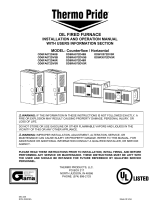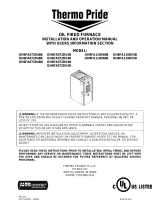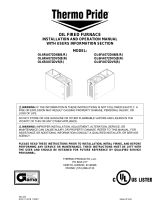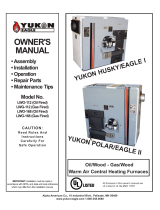
Products
Commercial
Installation
Operator’s
Nov-99
Heating
Furnace
And
Manual

Cox systems are shipped “ready to use”. All Employ qualified, experienced installers, to
necessary standard equipment, controls, and wiring insure the safe and efficient operation of your
are packaged with the heating systems. heating system.
Use the supplied furnace and burner manual,
together, to install the system.
PACKING PROCEDURE…………2 SEQUENCE OF OPERATION…….. 8
FURNACE ASSEMBLY MAINTENANCE………………….. 9
DRAWINGS ….………………….. 3
WIRING DIAGRAM……………….10
FURNACE SPECIFICATIONS..…4
MISCELLANEOUS……………….. 11
CLEARANCES……………………5 A. FILTER RACK ……………….. 11
B. DRAFT HOOD ……………….. 11
INSTALLATION INSTRUCTIONS C. OIL BURNER BLAST TUBE
A. GENERAL ...………………….. 5 LOCATION ………………….11
B. FLUE………...…………………5 D. BLEEDER TUBE …………….. 12
C. COMBUSTION AIR
SUPPLY ……………………… 6
D. BLOWER ADJUSTMENT…… 6
E. BURNER INSTALLATION…. 7
PACKING
1 – Package - 1 – Package-
Prewired and tested furnace assembly: Gas or oil burner:
1- Heat exchanger/combustion chamber and 1- Oil or gas burner and controls
casing 1- Oil nozzle
1- Blower and pulley 1- Instruction manual and literature
1- Motor and pulley 1- Gas burner mounting flange
1- Belt (2 on dual drives)
1- Instruction envelope and (2) wiring diagrams
1- Fan limit installed 1 – Package-
1- Oil burner mounting flange Draft control or draft hood
NOTE: Actual packing may vary according to sizes, weights, models, custom jobs, etc. Optional
equipment may or may not be packed separately.
FOR YOUR SAFETY FOR YOUR SAFETY
If you smell gas: Do not store or use gasoline
1. Open windows or other flammable vapors
2. Don’t touch electrical switches and liquids in the vicinity of
3. Extinguish any open flame this or any other appliance.
4. Immediately call your gas supplier.
DO NOT DESTROY THIS MANUAL
Please read carefully and keep in a safe place for future reference.
TABLE OF CONTENTS
2

ASSEMBLIES
A. Casing Jacket F. Stack
G. C
K. Inspection Port
onnector L. Fiberglass Rope Seal
H. Heat hanger M. Combustion Chamber
D. Radiator I. Heat Exchanger Baffle N. Refractory Lining
E. Radiator Baffle O. Burner Port
B. Fan and Motor
C. Felt Pad Exc
J. Air Tubes
3

SPECIFICATIONS
izontal Units)
SO-225 SO-
25,000 400
put-Gas BTU/HR 281,250 375,000 500,000
HO-225 HO-300 HO-400
Output BTU/HR 225,000 300,000 400,000
Input –Gas BTU/HR 281,250 375,000 500,000
Input-Oil GPH 2.00 2.50 3.50
CFM @ .33 WC ESP 2400 3400 4400
Blower Motor HP 3/4 1 1-1/2
Stack Diameter (in.) 9 10 12
LO-Series (Low-Boy Units)
Model LO-225 LO-300 LO-400
Output BTU/HR 225,000 300,000 400,000
Input-Gas BTU/HR 245,000 375,000 500,000
Input-Oil GPH 2.00 2.50 3.50
CFM @ .33 WC ESP 2400 3400 4800
Blower Motor HP 3/4 1 1-1/2
Stack Diameter (in.) 9 10 12
NOTES: 1. Gas burner through 40 ,000 BTU are AGA listed.
2. Oil Burner is UL listed
3. Rights retained to cha e specifications and ratings
without notice or liability.
SO Series (Hor
Model SO-300 400
utput BTU/HR 2 300,000 ,000 O
In
Input-Oil GPH 2.00 2.50 3.50
CFM @ .33WC ESP 2400 3000 4400
Blower Motor HP 3/4 1 1-1/2
Stack Diameter (in.) 9 10 12
HO Series (High-Boy Units)
Model
0
.
ng
4

CLEARANCES
Un nstruction,
and/
such
othe
ABO
FLU
W
com
SO
Ma
clea
6” a
6” above horizontal warm air duct within 6” of
furn
48”
18” om flue pipe in any direction.
6” f
6” f right side of furnace.
6” f
6” f floor.
INSTALLATION
A.
1.
).
2. agram. One
blower door
opy is placed with this manual.
3.
lower drive adjustment in D.5.
4.
tor.
5.
ds through hanging lugs on furnace. Mount
6. ing to NFPA standards
phlet No.31 or NO. 54 for gas.
7.
andards for the installation of heat producing
nditioning, warm air heating and ventilating
systems
the ventilating opening into the furnace
room shall be not less than twice the area of the flue
outlet.
all electrical
ing.
all bear the
l listee’s
ion.
not be
em.” UL
ONLY.
ndards
9. Air requirement into the furnace room for
satisfactory combustion is an area not smaller
than twice the cross sectional area of the flue
pipe. See burner manual.
B. Flue
without
lue and of
aft. Before
chimney
paired if
8”x8”
2”
2”
uld be removed from the
urner is installed. For best
preferably from .02 to .03
inches at the inspection door and from .05 to .06
Area of
less materials used in building co
or application of the heating equipment are of
a nature that local authorities to require
Ready access shall be provided for
rwise, the clearance about the furnace should be:
components in service.
VE-6”, SIDES AND REAR-6”, FRONT-48”,
E PIPE-18”.
Draft regulator shall bear the listed mark
RNING: LO Models must be placed on non-
The combination fan and limit control sh
control listee’s name and listed marking.
A
bustible flooring only.
The safety control shall bear the contro
(Horizontal) clearances
be installed in an alcove with the following
name, listed markings and group designat
y
rances to unprotected combustible material:
ove furnace casing, bonnet or plenum.
SO-300 and SO-400 “Air filters shall
mounted on the unit or in the air duct syst
b
ace.
from front of furnace.
fr
rom back of furnace.
rom
rom any side of plenum.
rom
General
When burner is furnished with separate flange,
caution should be used to insure the air tube
8. Must be installed according to NFPA sta
for the installation of air-conditioning, warm air
penetrating the chamber to within ½” of the
inside chamber surface. (Don’t push in too
heating and ventilating systems.
far
Wire burner as per wiring di
diagram is fixed to the inside of the
and a c
See installation and operation instructions for
b
OIL MOTOR according to instructions on
The chimney must be in good condition
mo
Suspend SO units by means of inserting hanging
cracks or openings or obstructions in the f
sufficient height to prevent a down dr
ro
LO models on non-combustible floor only.
installing an oil burner, the smoke pipe and
should be thoroughly cleaned and re
Must be installed accord
for installation of oil burning equipment.
required.
Pam
Must be installed according to Building Code
Minimum recommended chimney sizes: Oil
Two gallons of oil per hour and under …..
St
appliances: heating, ventilating, air-
Two to three gallons of oil per hour…8”x1
Over three gallons of oil per hour….12”x1
co
.
All manual dampers sho
smoke pipe before an oil b
lts the draft should beresu
5

6
The draft may be accurately
red with any good draft gauge.
ractically all installations. Proper, uniform draft
ator will usually pay for itself in a
ort time through a substantial savings in fuel costs.
ney sizes: Gas
Draft Hood &
Flue Pipe Size
”
320,000………………………….. 8”
……………….. 9”
…….. 10”
……………….. 11”
….. 12”
…………….. 13”
00………………………... 14”
000,001-1,140,000……………………… 15”
If the flue pipe exceeds 10 ft. in length, or
2 elbows use next size larger
.
C.
OIL
D install in rooms with insufficient air to
p
inst
to ent less
lack flame will be
unit ldings of conventional frame, brick or
win
adeq r
inst
outs he outside
twic
each
GPH
the ng by at least four percent. The
om should be isolated from any area served by
xhaust fans. Do not install an exhaust fan in this
om.
tory combustion is 1 square inch of free area
ously, the
f thermometers, adjust the blower speed
ntil the temperature rise through the unit is equal to
5 degrees – 80 degrees (difference in temperature
etween air entering and leaving the unit).
Unless the temperature of the air entering the units
excessively high (75 degrees or more) such
djustment will result in continued burner operation
ith a high limit setting of 180 degrees to 200
egrees. Should it be impossible to gain an 85
egree temperature rise through the unit, the
dications are that the fan is running too fast for the
en
n
than
ir rcuited back to
In
low thermostat to highest
ti purposes of continued burner operation
stment) and limit control 180 degrees to
not as reliable as that described in the
by the
r
n
high
ation
NOTE: Do not exceed motor rating.
inches at the stack.
measu
Excessive draft causes high stack temperatures and
consequently a waste of fuel. Therefore, a reliable
draft regulator is strongly recommended for
p
insures efficient, economical operation of the burner.
A good draft regul
sh
Minimum recommended chim
Input/hour
Up to 120,000…………………………... 5”
120,001-180,000………………………….. 6
180,001-250,000………………………….. 7”
250,001-
320,001-410,000…………
410,001-510,000……………………
510,001-610,000…………
610,001-730,000………………………
730,001-860,000……………
860,001-1,000,0
1,
NOTE:
contains more than
draft hood
pipe and
Combustion Air Supply
o not
sup ly combustion. Occasionally, it is necessary to
all windows or louvers in a door to these rooms,
obtain sufficient air and to prev
atmospheric air pressure in the room. If there is a
of combustion air, the burner
yellow and formation of soot will occur in heating
. In bui
stone construction without utility rooms, basement
dows, or stair doors, infiltration is normally
uate to provide air for combustion and fo
operation of the barometric draft control. For
allation in an enclosed utility room with an
ide wall, a fresh air opening to t
should be made with a free cross sectional area of
e the area of the flue outlet of 100 sq. inches for
gallon nozzle size (Example: 10x10 for 1.00
). For each 1,000 feet above sea level, increase
fresh air openi
ro
e
ro
GAS
Fresh air requirement into the furnace room for
atisfac
s
for each 1,000 BTU input and a minimum of 100 sq.
in.
D. Blower Adjustment
Because the Cox Heating unit is so versatile in its
application, it is impossible to be specific in
commending blower speed. Obvi
re
quantity and quality of the duct work and the manner
in which it is applied affects the air delivery.
To adjust blower speed to the applied conditions, it
is recommended that the thermostat be set at highest
setting to gain prolonged burner operation. By
eans o
m
u
7
b
is
a
w
d
d
in
int ded application of the furnace. Should the air
bei g supplied to the unit be at a temperature higher
95 degrees, the indications are that the heated
leaving the unit is being short cia
th
e unit. The remedy is revision of the supply
system, return system, or both.
many instances, it will be possible to adjust the
er speed by setting the
b
se
t ng (for
during adju
200 degrees, increasing then, the blower speed until
the burner no longer cuts out on high limit. Should
the burner cycle on high limit setting, indications are
that the duct static pressure is higher than intended
by the manufacturer, or the temperature of the air
being supplied the unit is excessive. This latter
method is
foregoing paragraph which will be applied
better qualified installer. Should the blowe
r moto
cut out, indications are: inadequate firing rate, fa
off setting too high, overload of motor, too
temperature air supplied to the unit or a combin
of same. Duct heaters have a minimum air
requirement as given in “Furnace Specification”
Section Chart.

7
flue-
flue
the
e of
ore
the
the
the
s
f
t
l opening may be used for
ocedure – The test procedure is as follows:
1 e burner shall be operated and the fuel rate
2
3
er operation.
Combustion – There must be openings into
Size – The burner shall be of adequate size for the
heating load as
rner certificate by the
ded by
e installer on the oil burner certificate to be placed
1) CO2 – The CO2 in the flue gas by analysis
ed when the stack
temperature is measured.
nk is buried underground, all pipe
nnections should be arranged so they will not be
oken if the tank should settle. Always use a good
e.
E. Burner Installation
OIL
Equipment – The following equipment shall be
available on each oil burner installation before the
tests are started:
1) Where the oil rate is not indicated on the
nozzle tip, a suitable device for determining
the rate in terms of gallons per hour fed to the
burner shall be used. This may be in the form
of a graduated glass vessel.
2) A suitable flue gas analyzer for determining
the percentage of CO2 in the flue gases.
3) A suitable draft gauge graduated in
hundredths of an inch of water.
4) A suitable thermometer to indicate the
gas temperatures.
5) Provision for inserting a thermometer in
pipe as follows: Not more than 12” from
furnace outlet, measured on the center li
n
the flue pipe, there shall be a hole not m
than ½” diameter, located at the side of
pipe on the center line so that
thermometer may be inserted horizontally.
The thermometer is to be placed so that
ensitive element is one fourth of the pipe diameter
rom the far side of the flue pipe. The opening around
he thermometer shall be sealed to prevent air
eakage. This same
checking draft and sampling flue gases.
Test Pr
) Th
adjusted to that required for the particular
installation.
) The draft then shall be adjusted to meet the
burner manufacturer’s specifications, both over
the fire and at the breeching. Refer to
“Installation Instructions” Section, B.
) Combustion air adjustments are to be made to
give the highest CO2 without visible smoke
(unburned carbon) at the chimney. If the
minimum required percentage of CO2 cannot be
obtained in the breeching, it will be permissible
to take CO2 over the fire, which will be
acceptable. In this event, both CO2 readings
shall be recorded after 10 minutes of operation.
Readings – During the period of operation to permit
flue gas temperature to reach maximum, periodic
readings of draft CO2 and oil rate shall be taken and
the average recorded on the certificate.
All controls and limiting devices shall be checked
for prop
Air for
the furnace room to admit free air to maintain
combustion, minimum opening of not less than twice
the area of flue outlet of furnace.
furnace and the connected
mended on the oil bu
recom
installer. Models and Firing Rate : See “Furnace
Specification” Section.
Certificate – Following installation of the burner,
certain test data shall be obtained and recor
th
with each oil burner installation. The test shall cover
the following points: CO2 in the flue gas by
analysis, draft, stack temperature, firing rate, and
smoke.
Requirements – The standard requirements as
approved by the industry as follows:
shall not be less than 8%.
2) Draft - The draft shall be in accordance with
specifications in the manufacturer’s
installation manual. An automatic draft
regulator or its equivalent is required.
3) Stack Temperature – The stack temperature
shall be measured on the furnace side of
automatic draft regulator and not more than
12 inches from the smoke connection. The
stack temperature shall be measured at the
certified firing rate. If an automatic draft
regulator is built into the furnace, such
regulator shall be clos
4) Firing rate – The firing rate shall be based on
the burner manufacturer’s recommendation
for the existing total connected load. Burner
shall be fired at that rate.
5) Smoke – During the above test, there shall be
no visible smoke at the chimney.
6) Installation Manual – The burner shall be
installed in accordance with manufacturer’s
installation manual.
Fuel Tank Connections – Pipe connections between
fuel tank and the oil burner should be made with 3/8”
copper tubing and brass fittings, however, galvanized
pipe is quite satisfactory. All joints should be sealed
with key paste or other good oil resisting compound,
and pulled up tight. Where fuel tank is installed in a
basement, a one-pipe system to the burner will be
found entirely satisfactory.
When fuel ta
co
br
leak-proof check valve in the suction lin

8
r the installation of the
u er, tank, and controls have been completed and
refully checked.
3)
ca
pu
res
4)
5)
6)
7)
op
8) Cl
ad
sh
AS
OIL
3.
4.
5.
6.
7.
8.
limit “OFF” setting.
,
h
test shall cover the
llowing points: CO2 in the flue gas by analysis, draft,
the flue gas by analysis shall
not be less than 8%.
s
r and not more than 12 inches from the
ion. The stack temperature shall be
m
4)
ex
at
5)
s
6) In
in
ma
GAS
1. h
2.
3. i
4.
5. Fla
6. M .
Adjusting the Burner – Afte
rn
b
all wiring ca
1) Leave line switch open and set thermostat well
above room temperature.
2) Make sure that the resetting device on the control
panel is in operating position.
Set can at gauge port or bleeder tube opening to
tch oil. Close line switch and allow burner to
mp oil until flows clear. If control locks out,
et, and when oil comes out clear, open line
switch and replace plug or gauge.
Close line switch. The burner then should start.
Check oil pressure and adjust, if necessary, to
100 lbs.
Adjust air shutter on burner so that flame burns
clean with slightly smoky tips. Burner is shipped
with air shutter closed.
Start and stop the burner several times by
ening and closing main line switch.
ose main line switch and change thermostat
justment to below room temperature. Burner
ould stop.
G
Size – The burner shall be adequate size for the
furnace and the connected heating load as
recommended on the gas burner certificate by the
installer. Models and BTU input rating: See “Furnace
Specification” Section.
SEQUENCE OF OPERATION
Thermostat calls for heat. 1.
2. Protector relay energizes motor and ignition
transformer.
Pump supplies fuel to nozzle.
Burner ignites.
Furnace blower activates at blower “ON” setting.
Area is heated and thermostat is satisfied.
Protector relay de-energizes burner components.
Furnace blower continues to operate until fan
9. End of cycle.
Certificate – Following the installation of the burner
certain test data shall be obtained and recorded by the
installer on the gas burner certificate to be placed wit
each gas burner installation. The
fo
stack temperature, firing rate.
Requirements – The standard requirements as
approved by the industry are as follows:
1) CO2 – The CO2 in
2) Draft – The draft shall be in accordance with
specifications in the manufacturer’s installation
manual. An automatic draft regulator or it’
equivalent is required.
3) Stack Temperature – The stack temperature shall
be measured on the furnace side of automatic draft
regulato
smoke connect
measured at the certified firing rate. If an automatic
draft regulator is built into the furnace, such
regulator shall be closed when the stack
te perature is measured.
Firing Rate – The firing rate shall be based on the
burner manufacturer’s recommendation for the
isting total connected load. Burner shall be fired
that rate.
Smoke – During the above test, there shall be no
vi ible smoke at the chimney.
stallation Manual – The burner shall be installed
accordance with manufacturer’s installation
nual.
T
Burner motor starts and spark ignition begins.
lot valve opens.
ermostat calls for heat.
P
Pilot ignites.
me sensor proves pilot.
ain gas valve is opened
7. Burner ignites.
8. Furnace blower activates at blower “ON” limit
setting.
9. Area is heated and the thermostat is satisfied.
10. Thermostat de-energizes burner components.
11. Furnace blower continues to operate until fan
limit “OFF” setting.
12. End of cycle.

9
has ld be rechecked during
func bustion is proper
diffe
OIL
2)
6) n that fire burns clean and that draft
gulator is in good working order and adjusted
1) Check and adjust electrode assembly.
2) Oil motor.
3) Check all gas lines connections and make
sure that there are no leaks.
4) Test starting and stopping of burner by
an and that
draft regulator is in good working order and
adjusted for proper amount of draft.
N
i nual.
4.
1 smoke, 8-9% CO2).
MAINTENANCE
Servicing the Burner – After the burner installation
been put in service, it shou
the first two weeks to make certain that it is
tioning properly. Note the com
and there are no gas or oil leaks, also that the
rent controls perform correctly.
ery oil burner should be serviced a Ev t least once a
year, preferably at the beginning of the heating
season.
1) Remove electrode assembly and clean, replace
nozzle.
Oil motor.
Check all oil lines con
3) nections and make sure
that there are no leaks.
Clean strainers in fuel unit.
4)
5) Test starting and stopping of burner by moving
thermostat.
Make certai
re
fo
r proper amount of draft.
GAS
Every gas burner should be serviced at least once
a year, preferably at the beginning of the heating
season.
moving thermostat.
5) Make certain that fire burns cle
OTE: For complete burner operation
nstructions see the respective burner ma
Employ only qualified personnel to service heating
equipment. For safety, the main power switch must
be in the “OFF” position.
1. Air filters – Inspect filters monthly and replace
or clean when necessary.
Oiling – Oil the burn2. er motor and blower motor
according to the instructions on the motors. The
blower bearing may be permanently lubricated
and sealed and require no oil or grease.
3. Belts – Check belts for wear and proper tension.
Belts may stretch or wear and require
replacement. Belt tension may be checked by,
depressing the belt at a point halfway between
the pulleys. The belt should travel one inch.
Burner – Refer to the manual that was supplied
with the burner for speci
fic information. Oil
nozzles should be replaced at least once in a
season. Gas orifices should be cleaned yearly.
Electrodes should be checked and set according
to the burn
er manual. The blower wheel and
housing should be cleaned if necessary.
5. Combustion – Using proper equipment, recheck
for proper and efficient combustion (No CO, or
less than #

10

11

12
-
 1
1
-
 2
2
-
 3
3
-
 4
4
-
 5
5
-
 6
6
-
 7
7
-
 8
8
-
 9
9
-
 10
10
-
 11
11
-
 12
12
Ask a question and I''ll find the answer in the document
Finding information in a document is now easier with AI
Other documents
-
Beckett AFII85 Installation guide
-
Rheem OBF Series Installation Instructions Manual
-
Yukon LWG-168 Owner's manual
-
 Thermo Products OD6FA072DV5R User manual
Thermo Products OD6FA072DV5R User manual
-
 Thermo Products OH6FA072D48 Installation guide
Thermo Products OH6FA072D48 Installation guide
-
 Thermo Products OH8FA119DV5B User manual
Thermo Products OH8FA119DV5B User manual
-
 Thermo Products OL6FA072D48(B/R) User manual
Thermo Products OL6FA072D48(B/R) User manual
-
York P4LBX20F19001 User manual
-
 Yukon Advanced Optics Oil Furnace User manual
Yukon Advanced Optics Oil Furnace User manual
-
321 Studios FH110D48E User manual
















